
Overview
The article emphasizes various Google Ads bid strategies designed to significantly enhance the return on investment (ROI) for direct-to-consumer (DTC) brands. By seamlessly integrating Conversion Rate Optimization (CRO) with these strategies—such as:
- Manual CPC
- Target CPA
- Smart Bidding
companies can adeptly manage their advertising spend and maximize profitability. Successful case studies serve as compelling evidence, demonstrating substantial increases in conversion rates and average order values. This integration not only optimizes ad performance but also positions DTC brands for sustained growth in a competitive marketplace.
Introduction
In the competitive landscape of direct-to-consumer (DTC) marketing, the effectiveness of Google Ads is paramount to a brand's success. Companies encounter the challenge of selecting the right bidding strategy to maximize their return on investment (ROI). This article explores ten innovative Google Ads bid strategies designed to not only enhance visibility but also drive conversions. By equipping DTC brands with these essential tools, businesses can thrive in a digital marketplace.
How can organizations effectively leverage these strategies to transform clicks into loyal customers and achieve sustainable growth?
Parah Group: Comprehensive Conversion Rate Optimization for Google Ads Success
Parah Group excels in Conversion Rate Optimization (CRO), a crucial element for DTC companies aiming to improve their Google Ads bid strategies. By utilizing data-informed approaches and understanding consumer behavior, Parah Group empowers companies to maximize their advertising expenditure, significantly improving success rates. This comprehensive strategy ensures that every facet of an entity's online presence works synergistically to foster substantial growth, ultimately resulting in a higher return on investment (ROI) from using Google Ads bid strategies.
Regular CRO audits, ideally conducted quarterly, are essential for identifying key areas for improvement, such as optimizing landing pages and refining call-to-action (CTA) placements. By concentrating on high-impact strategies, companies can effectively tackle challenges like low sales rates despite high traffic, ensuring that every dollar spent on advertising leads to significant outcomes.
As highlighted in our FAQs, Parah Group differentiates itself by prioritizing profitability and sustainable growth, which is vital for maximizing revenue without increasing marketing spend. For instance, a $30M apparel company experienced a 35% increase in conversion rates after implementing a redesigned homepage that emphasized social proof and optimized product pricing. Similarly, a cleaning product company enhanced its average order value (AOV) by 80% through strategic bundling and price testing.
By focusing on these actionable insights, companies can address challenges effectively and ensure their advertising efforts yield significant returns.

Manual Cost-per-Click (CPC) Bidding: Control Your Ad Spend Effectively
Manual CPC bidding provides advertisers with the flexibility to implement Google Ads bid strategies by setting their own maximum bids for each click. This approach is particularly advantageous for DTC companies aiming to meticulously monitor their advertising expenses. By analyzing performance metrics, these companies can adjust their Google Ads bid strategies based on the keywords or advertisements that yield the highest results, thereby ensuring efficient budget allocation.
In conjunction with expert Conversion Rate Optimization (CRO) strategies from Parah Group, which emphasize sustainable growth and profitability, DTC brands can significantly enhance their return on investment. Parah Group's CRO strategy ensures that every dollar spent on advertisements translates into substantial outcomes, thereby improving overall campaign effectiveness.

Target Cost-per-Action (CPA) Bidding: Optimize for Desired User Actions
Target CPA bidding empowers advertisers to set a target cost for acquiring specific actions, such as purchases or leads. This strategy proves particularly advantageous for DTC companies with established performance objectives. By optimizing bids to achieve these actions, companies can ensure their advertising efforts directly contribute to their bottom line, thereby maximizing ROI.
Consider the Parah Group, which has successfully transformed DTC labels through innovative Conversion Rate Optimization (CRO) approaches. A notable example is their $30M clothing line, which experienced a remarkable 35% increase in success rates following the implementation of targeted enhancements. Similarly, a $15M cleaning product label saw its average order value (AOV) soar by 80% through strategic adjustments. These cases illustrate how effective CRO can significantly enhance the outcomes of advertising strategies, including Google Ads bid strategies like Target CPA auctions.
These proven results underscore the critical importance of integrating CRO with advertising efforts to drive revenue growth and enhance profitability. By adopting such strategies, companies can not only achieve their performance goals but also secure a competitive edge in the market.

Maximize Conversions Bidding: Leverage Automation for Higher Conversion Rates
Maximize Conversions pricing is an automated strategy within Google Ads bid strategies that is designed to optimize bids in real-time, aiming to achieve the highest possible number of successful outcomes within a specified budget. This method proves particularly beneficial for DTC companies seeking to streamline their bidding processes while maintaining a strong focus on improving results. By leveraging Google's advanced machine learning capabilities, businesses can enhance campaign performance without the necessity for continual manual adjustments.
For optimal results, it is recommended that accounts secure a minimum of 30 conversions each month when employing the Maximize Conversions strategy. Understanding this benchmark is crucial for DTC companies to grasp the prerequisites for effective implementation of the approach. The success rates associated with automated pricing strategies, such as Maximize Conversions, have shown significant promise for DTC brands. These Google Ads bid strategies not only simplify the bidding process but also enhance success rates by facilitating real-time adjustments based on various auction signals, including user behavior and market conditions. For instance, brands that have adopted this method frequently report increased transaction volumes, as the algorithm adeptly allocates budget to optimize outcomes.
Digital marketing experts underscore the importance of automation in achieving results. As Michelle Morgan aptly noted, 'Automated pricing streamlines your proposal approach according to your budget and objectives,' highlighting how this strategy can lead to improved outcomes with diminished manual oversight. DTC brands utilizing Google Ads bid strategies like the Maximize Conversions approach can expect to see enhanced performance metrics, including higher customer acquisition rates and improved return on investment.
Furthermore, the advantages of automated bidding extend beyond mere convenience. Brands can achieve substantial cost savings, as the strategy is designed to optimize spending while maximizing results. This is especially critical in today’s competitive landscape, where every transaction plays a role in overall profitability. To further bolster these efforts, partnering with a specialized CRO agency such as Parah Group can provide tailored strategies focused on sustainable growth and profitability. It is vital to ensure that adequate tracking mechanisms are established for Maximize Conversions to operate effectively. Additionally, companies must be aware of potential risks, such as rising costs per conversion in competitive markets, and the necessity for ongoing campaign management to ensure the approach remains effective over time. By adopting Maximize Conversions, DTC companies can adeptly navigate the complexities of digital advertising, ensuring that their campaigns are not only efficient but also aligned with their growth objectives.
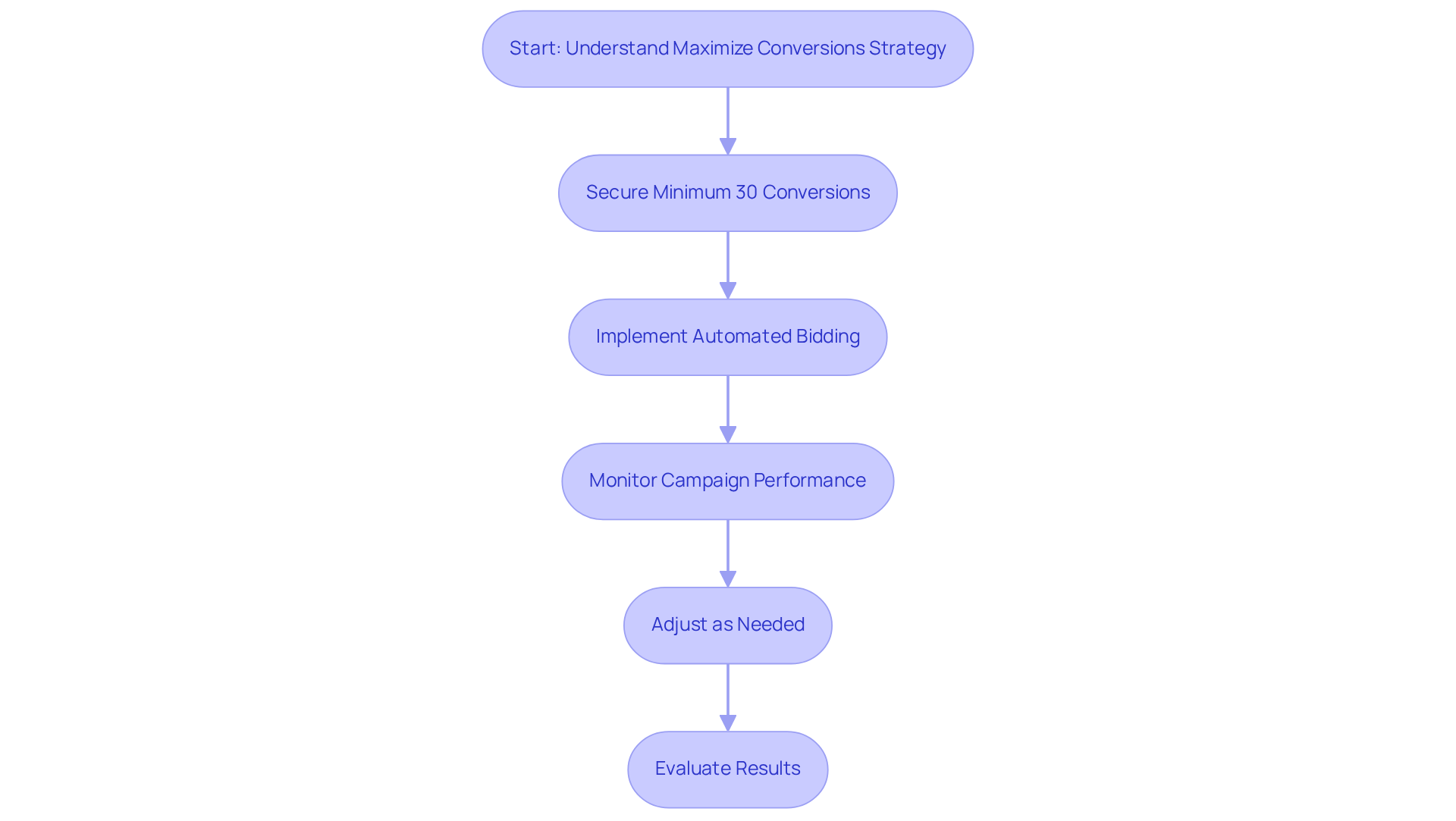
Target Return on Ad Spend (ROAS) Bidding: Focus on Profitability
Target ROAS strategies empower advertisers to set offers aimed at achieving a precise return on ad expenditure, making this approach essential for DTC companies prioritizing profitability. By leveraging historical performance data, these companies can formulate realistic ROAS targets that align with their financial objectives. This strategy not only maximizes revenue but also aids in effectively managing advertising costs.
The success of Target ROAS strategies is evident in the achievements of leading DTC companies. For instance, Parah Group enabled a $30M clothing company to realize a 35% increase in conversion rates by optimizing their homepage and implementing strategic upsells. This case illustrates how targeted approaches can significantly enhance profitability. Similarly, a $15M cleaning product brand elevated their average order value (AOV) by 80% through focused pricing strategies and bundle offers, showcasing the direct impact of effective bidding techniques on revenue growth.
To set practical ROAS goals, companies must consider factors such as:
- Their average order value
- Customer lifetime value
- Market competition
By analyzing these components, DTC companies can create achievable benchmarks that inform their advertising strategies. Statistics reveal that companies utilizing Google Ads bid strategies enjoy a 30% higher return on investment compared to those relying on traditional methods, highlighting the importance of this approach in the current competitive landscape.
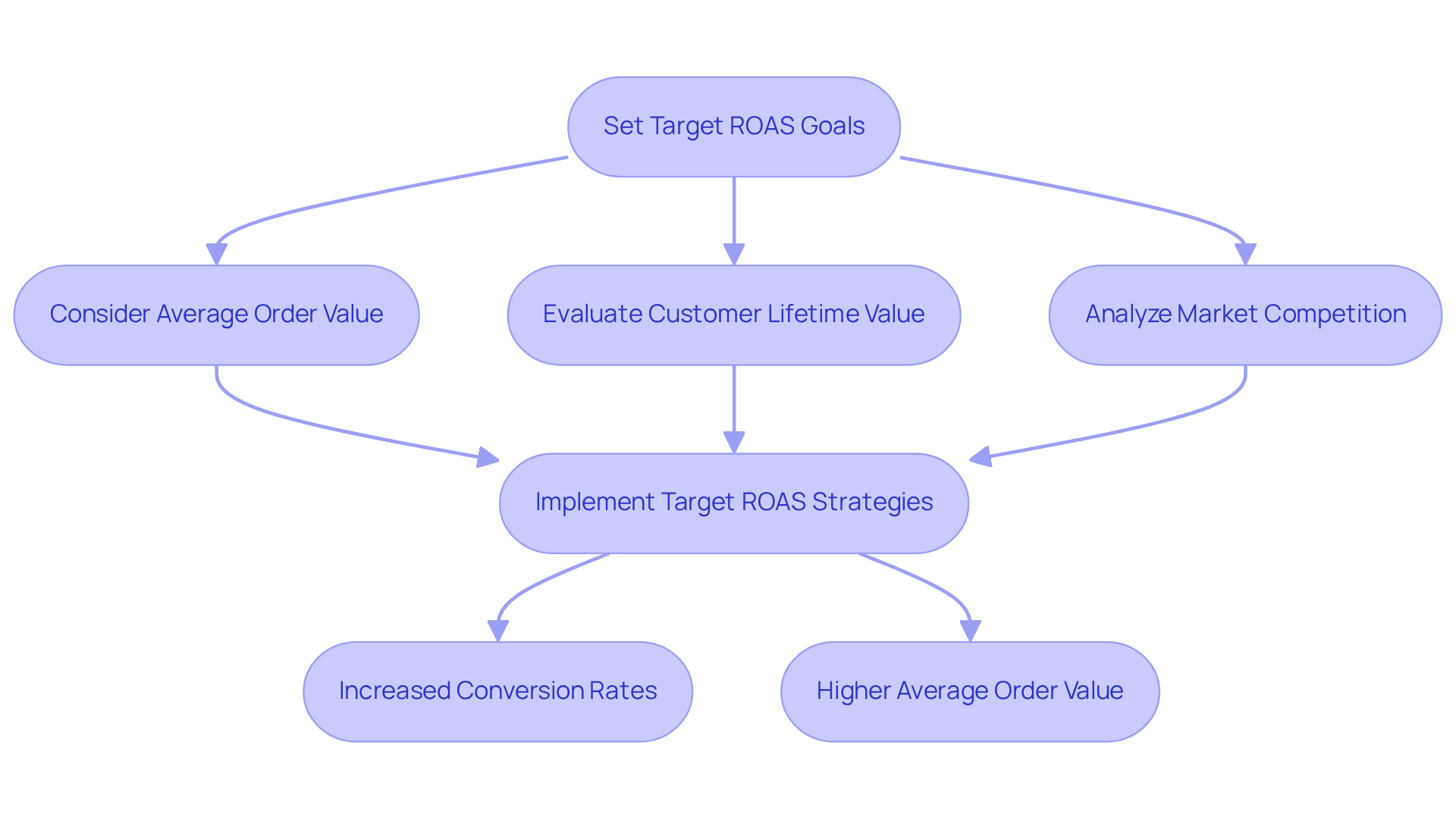
Enhanced Cost-per-Click (ECPC) Bidding: Balance Control and Automation
Enhanced Cost-per-Click (ECPC) Bidding: Balancing Control and Automation
Enhanced CPC bidding is a powerful strategy that allows advertisers to set manual bids while empowering Google to adjust those bids automatically based on the likelihood of conversion. This hybrid approach is particularly advantageous for direct-to-consumer (DTC) companies that seek to maintain control over their advertising expenditure while leveraging automation to boost performance. By harnessing historical data, these companies can optimize their bids for superior outcomes.
This method not only provides a sense of control but also integrates the efficiency of automated bidding. As DTC companies navigate the complexities of digital advertising, Google Ads bid strategies such as Enhanced CPC bidding stand out as a solution that merges manual oversight with intelligent automation. The result is a refined bidding strategy that enhances the likelihood of conversions without sacrificing budgetary control.
In conclusion, by utilizing Enhanced CPC bidding, companies can strategically position themselves to achieve better results in their advertising efforts. The blend of manual and automated bidding, supported by data-driven insights, allows for a more effective allocation of resources and maximizes the potential for return on investment.

Maximize Clicks Bidding: Drive More Traffic to Your Ads
Maximize Clicks bidding is an automated strategy designed to drive significant traffic to your ads within a specified budget. This method is particularly advantageous for DTC companies seeking to enhance their visibility and attract potential clients. By focusing on clicks, businesses can improve their online presence and potentially increase user engagement with their advertisements.
For instance, Parah Group has successfully transformed the profitability of several DTC brands through innovative Conversion Rate Optimization (CRO) techniques. A notable example is a $30M apparel company that achieved a remarkable 35% increase in conversion rates by optimizing their homepage and implementing strategic upsells, such as personalized recommendations. Similarly, a $15M cleaning product brand increased its average order value by 80% through targeted pricing strategies and bundling options. These proven results underscore the effectiveness of traffic management, coupled with strategic CRO, in driving substantial revenue growth for DTC brands.
To optimize the efficiency of your Google Ads, it is crucial to regularly evaluate and adjust your pricing strategies based on performance data. This proactive approach will ensure that your advertising efforts yield the maximum possible returns.
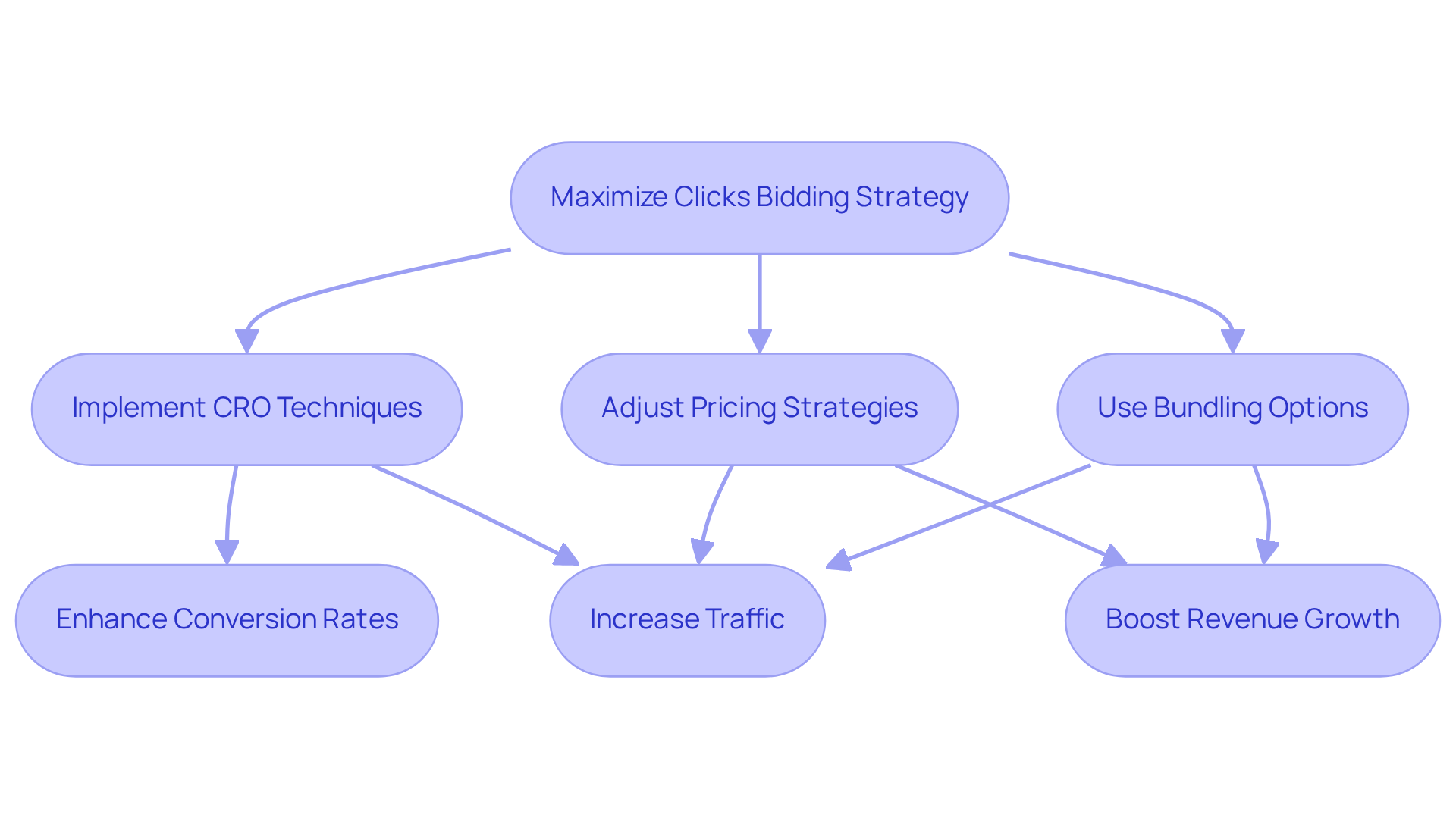
Target Impression Share Bidding: Ensure Your Ads Are Seen
Target Impression Share bidding is one of the Google Ads bid strategies that allows advertisers to strategically set bids to achieve a specific impression share in search results. This approach is essential for direct-to-consumer (DTC) companies striving to ensure their ads reach potential customers, especially in highly competitive markets. By focusing on impression share, companies can significantly enhance their visibility and brand recognition, ultimately leading to increased traffic and conversions.
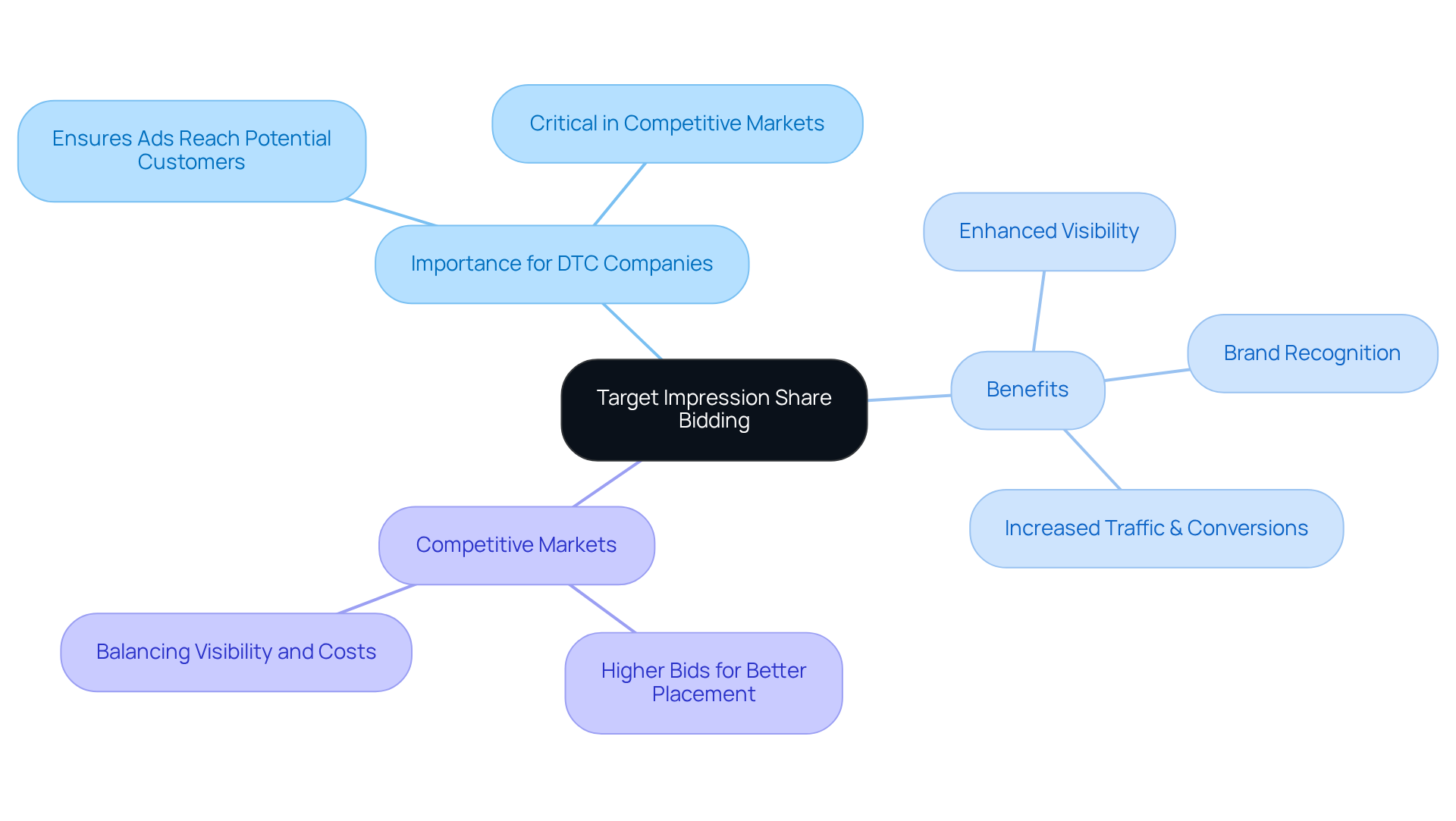
Cost-per-Thousand Impressions (CPM) Bidding: Boost Brand Awareness
Cost-per-Thousand Impressions (CPM) bidding represents a strategic shift in advertising, allowing advertisers to pay for ad impressions rather than clicks. This method is particularly advantageous for Direct-to-Consumer (DTC) companies aiming to enhance brand awareness and engage a broader audience. By prioritizing impressions, these companies can significantly improve their visibility and recognition in the marketplace. This increased exposure can lead to heightened traffic and, ultimately, greater potential for conversions in the future.
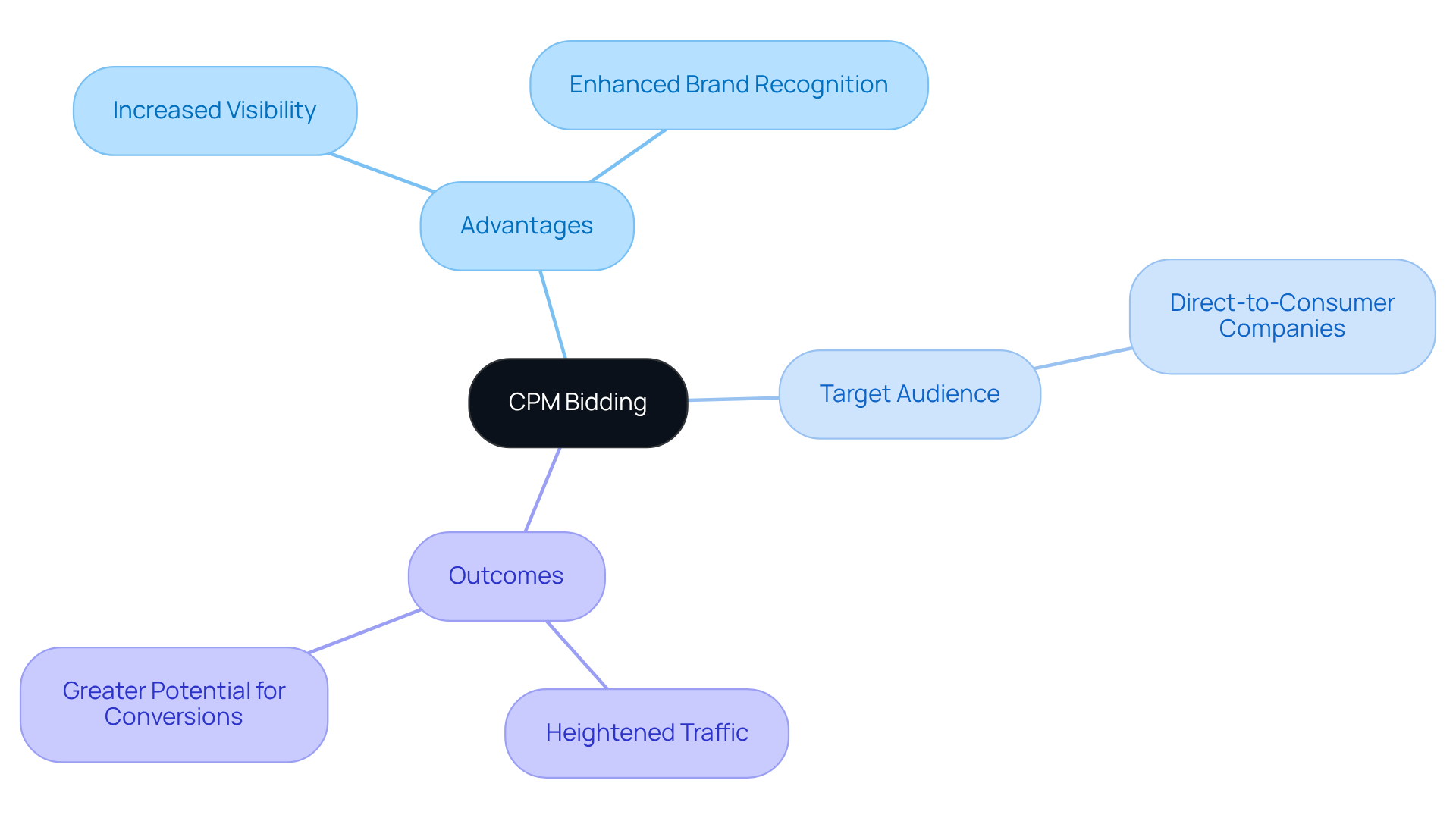
Smart Bidding: Harness Machine Learning for Optimal Results
Smart Bidding is a cutting-edge example of Google Ads bid strategies that utilizes machine learning to optimize bids in real-time, adapting dynamically to various signals such as user behavior and contextual factors. This innovative approach is particularly advantageous for Direct-to-Consumer (DTC) companies seeking to enhance their advertising performance without the burden of constant manual adjustments. By harnessing the capabilities of machine learning, brands can significantly improve their overall return on investment (ROI) in Google Ads campaigns through effective Google Ads bid strategies, achieving superior results.
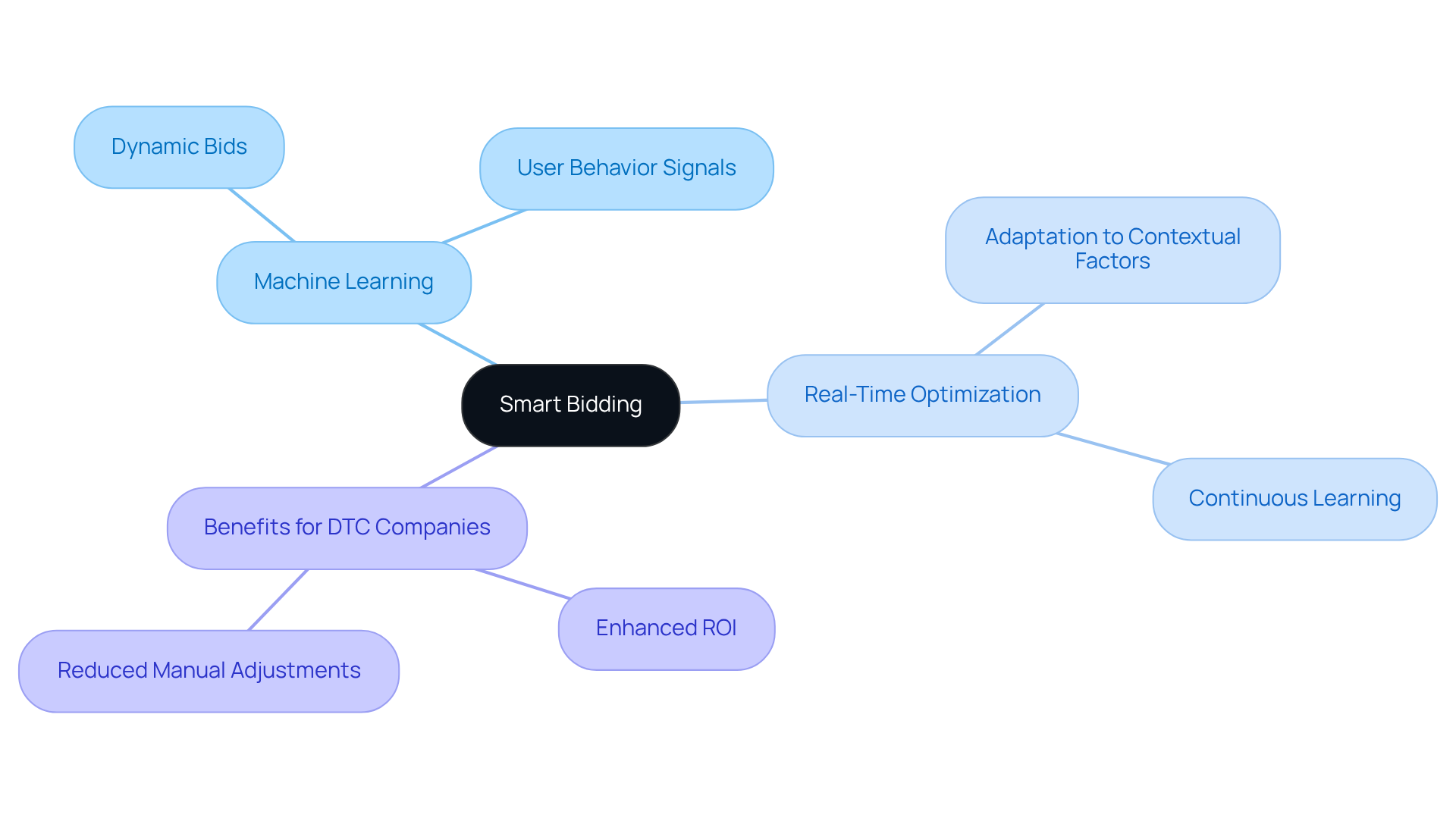
Conclusion
Implementing effective Google Ads bid strategies is essential for Direct-to-Consumer (DTC) brands aiming to enhance their return on investment (ROI). By employing a variety of approaches, such as:
- Manual CPC
- Target CPA
- Smart Bidding
companies can optimize their ad spend while ensuring that their campaigns achieve substantial results. The integration of Conversion Rate Optimization (CRO) techniques further amplifies these efforts, allowing brands to transform their advertising strategies into powerful revenue-generating tools.
Key strategies discussed throughout this article include:
- The importance of manual control through CPC bidding
- The automation benefits of Maximize Conversions and Smart Bidding
- The focus on profitability with Target ROAS
Notable case studies demonstrate how DTC brands have successfully increased conversion rates and average order values by leveraging these strategies, highlighting the synergy between effective bidding and CRO practices.
As the digital advertising landscape continues to evolve, DTC brands must remain agile and informed about the latest bidding strategies to stay competitive. By adopting a data-driven approach and partnering with experts like Parah Group, companies can not only boost their advertising efficiency but also ensure sustainable growth and profitability. Embracing these strategies is not just an option; it is a necessity for brands aiming to thrive in an increasingly crowded marketplace.
Frequently Asked Questions
What is Conversion Rate Optimization (CRO) and why is it important for DTC companies?
Conversion Rate Optimization (CRO) is a strategy aimed at improving the effectiveness of online advertising efforts, particularly for Direct-to-Consumer (DTC) companies. It is crucial as it helps maximize advertising expenditure, leading to significantly improved success rates and higher returns on investment (ROI) from Google Ads.
How does Parah Group approach CRO?
Parah Group utilizes data-informed methods and insights into consumer behavior to create comprehensive CRO strategies. They conduct regular audits, ideally quarterly, to identify areas for improvement, such as optimizing landing pages and refining call-to-action placements.
What results have companies achieved through Parah Group's CRO strategies?
Companies have seen substantial improvements, such as a $30M apparel company experiencing a 35% increase in conversion rates after redesigning its homepage, and a cleaning product company increasing its average order value (AOV) by 80% through strategic bundling and price testing.
What is Manual Cost-per-Click (CPC) bidding, and how does it benefit advertisers?
Manual CPC bidding allows advertisers to set their own maximum bids for each click on their ads. This gives DTC companies the flexibility to closely monitor their advertising expenses and adjust their strategies based on performance metrics to ensure efficient budget allocation.
How does Manual CPC bidding work in conjunction with CRO strategies?
When combined with Parah Group's expert CRO strategies, Manual CPC bidding helps DTC brands enhance their return on investment by ensuring that every dollar spent on advertisements leads to significant outcomes and improved campaign effectiveness.
What is Target Cost-per-Action (CPA) bidding, and who benefits from it?
Target CPA bidding allows advertisers to set a target cost for acquiring specific actions, such as purchases or leads. This strategy is particularly beneficial for DTC companies with established performance objectives, as it helps ensure that advertising efforts contribute directly to their bottom line.
Can you provide examples of success using Target CPA bidding?
Yes, Parah Group has successfully transformed DTC brands through CRO approaches. For instance, a $30M clothing line saw a 35% increase in success rates after targeted enhancements, while a $15M cleaning product label increased its AOV by 80% through strategic adjustments.
Why is integrating CRO with advertising strategies important?
Integrating CRO with advertising strategies is critical as it drives revenue growth and enhances profitability. By adopting such strategies, companies can achieve their performance goals and secure a competitive edge in the market.
FAQs











